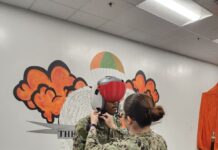Designers have used 3D Printing in fashion in several ways, but very few of the creations released so far can be decently worn by the end-consumer. Fashion designers threeASFOUR and Travis Fitch will probably change that with their ‘Chro-Morpho’ collection. Made in collaboration with Stratasys, the collection is inspired by the microscopic colors and light filtering of butterfly and insect wings.
This is not Stratasys’s first experience in the fashion industry. However, this collaboration reveals another way to leverage 3D Printing technology in fashion. Moreover, it shows the readiness of the manufacturer’s technology to embrace complex creations from the fashion industry, for high-end couture and, eventually, series production.
Using 3D Printing in fashion
Over time, fashion designers that harnessed 3D printing for their creations, usually printed elements separately and thereafter affixed them to clothing. The result remained nice but the wearability of the garment was not guaranteed.
Stratasys explored a different technique and decided to print directly on textiles. Such method offers more flexibility and integrity. More importantly, it offers an opportunity to a more functional garment which is ready for commercialization.
“We’ve created the skin-like illusion of switching shades and depth to portray the insect’s innate camouflage, color diversion and luminosity,” said Adi Gill, co-founder and creative director of threeASFOUR. “With 3D design and printing, we’ve embodied the fragility and light wing movement of the butterfly. It’s a stunning display of nature, fashion and technology.”
The production process takes around 17 hours.
One Greta-Oto dress from the collection, for example, uses a Stratasys-engineered lenticular effect to play with light and color. By printing spherical, fish scale-sized cells made of photopolymers directly onto polyester fabric, the color of the dress shifts with each small movement. The thousands of cells on the dress’s 27 parts consist of a clear lens with strips of color contained inside.
This was also the first fashion creation for the Stratasys J750 PolyJet™ printer. The J750 printer offers over 500,000 combinations of colors, textures, gradients and transparencies, and has the processing power and finesse to handle the delicate geometries and microscopic layers applied to the garments. This gives designers unlimited design freedom and potentially enables end users to be involved in the design.
“Within the next two years, I believe consumers will be able to purchase an array of 3D-printed garments from high-fashion brands,” said Stratasys Art, Design and Fashion Director Naomi Kaempfer. “And the result will be access to an explosion of unique color and texture combinations that are simply not possible through traditional methods.”
You can now post free of charge job opportunities in the AM Industry on 3D ADEPT Media.
For further information about 3D Printing, follow us on our social networks and subscribe to our newsletter!
Would you like to be featured in the next issue of our digital magazine? Send us an email at contact@3dadept.com






